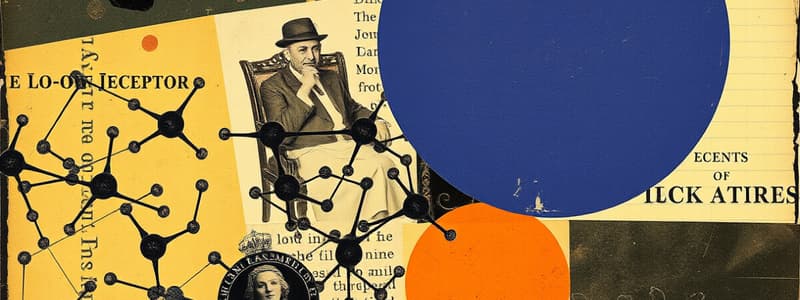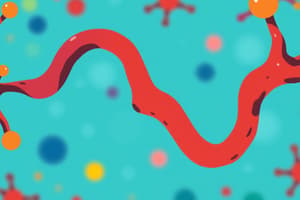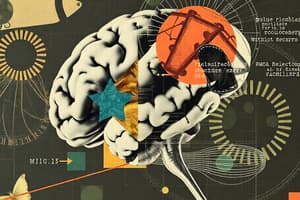Podcast
Questions and Answers
What is the primary function of agonists in relation to receptors?
What is the primary function of agonists in relation to receptors?
- They have no effect on neuronal communication.
- They block receptor activity.
- They prevent neurotransmitter release.
- They bind to receptors and enhance neuron activity. (correct)
What distinguishes antagonists from agonists?
What distinguishes antagonists from agonists?
- Antagonists increase neurotransmitter availability.
- Antagonists have no effect on the receptor.
- Antagonists bind to receptors but do not activate them. (correct)
- Antagonists enhance neuronal firing.
Which of the following statements is true regarding the diversity of receptors?
Which of the following statements is true regarding the diversity of receptors?
- Receptors can exist without neurotransmitters. (correct)
- All receptors have identified neurotransmitters.
- Receptors only bind to one specific type of neurotransmitter.
- There are no classifications for receptors.
Which neurotransmitter does not typically interact with a receptor type listed in the diversity of receptors?
Which neurotransmitter does not typically interact with a receptor type listed in the diversity of receptors?
Which of the following receptor types is specifically identified as GABA-related?
Which of the following receptor types is specifically identified as GABA-related?
Which amino acid is specifically present only in GABA cells?
Which amino acid is specifically present only in GABA cells?
What is the primary function of GABA transaminase?
What is the primary function of GABA transaminase?
What happens when glutamate levels are not effectively reduced by glial cells?
What happens when glutamate levels are not effectively reduced by glial cells?
How does GABA originate in the nervous system?
How does GABA originate in the nervous system?
What is a consequence of high glutamate levels in the brain?
What is a consequence of high glutamate levels in the brain?
What is the primary function of histamine in the brain?
What is the primary function of histamine in the brain?
Which amino acid is the precursor for the synthesis of catecholamines?
Which amino acid is the precursor for the synthesis of catecholamines?
Which neurotransmitter is primarily associated with the regulation of circadian rhythms?
Which neurotransmitter is primarily associated with the regulation of circadian rhythms?
Where are the cell bodies of dopamine and noradrenaline primarily located?
Where are the cell bodies of dopamine and noradrenaline primarily located?
Which enzyme is responsible for converting Tyrosine to L-DOPA?
Which enzyme is responsible for converting Tyrosine to L-DOPA?
What is the effect of anti-histamines on the brain?
What is the effect of anti-histamines on the brain?
Which neurotransmitter is specifically mentioned as projecting dopamine towards the nigrostriatal system?
Which neurotransmitter is specifically mentioned as projecting dopamine towards the nigrostriatal system?
What role do catecholamines play in the nervous system?
What role do catecholamines play in the nervous system?
What is the major role of acetylcholine in the nervous system?
What is the major role of acetylcholine in the nervous system?
Which statement accurately describes the nature of acetylcholine?
Which statement accurately describes the nature of acetylcholine?
What processes does acetylcholine modulate?
What processes does acetylcholine modulate?
Which of the following neurotransmitters is primarily excitatory alongside acetylcholine?
Which of the following neurotransmitters is primarily excitatory alongside acetylcholine?
What is cholinergic neurotransmission most associated with?
What is cholinergic neurotransmission most associated with?
Where are the cell bodies of acetylcholine neurons primarily located?
Where are the cell bodies of acetylcholine neurons primarily located?
What is the precursor for acetylcholine synthesis?
What is the precursor for acetylcholine synthesis?
Which process is NOT associated with acetylcholine?
Which process is NOT associated with acetylcholine?
What are the positive psychotic symptoms primarily associated with in schizophrenia?
What are the positive psychotic symptoms primarily associated with in schizophrenia?
Which receptor type is generally involved in producing positive symptoms of schizophrenia?
Which receptor type is generally involved in producing positive symptoms of schizophrenia?
What is the primary function of a dopamine D2 receptor antagonist in schizophrenia?
What is the primary function of a dopamine D2 receptor antagonist in schizophrenia?
What cognitive effect is linked to hypofrontality in schizophrenia?
What cognitive effect is linked to hypofrontality in schizophrenia?
How does increased dopamine impact the functioning of the dorsal striatum?
How does increased dopamine impact the functioning of the dorsal striatum?
What is the main role of mesocorticolimbic dopamine system in relation to schizophrenia?
What is the main role of mesocorticolimbic dopamine system in relation to schizophrenia?
What happens to D2 receptors when neuroleptics bind to them?
What happens to D2 receptors when neuroleptics bind to them?
Which condition is primarily linked to hypofrontality?
Which condition is primarily linked to hypofrontality?
Flashcards are hidden until you start studying
Study Notes
Neurons and Neurotransmitters
- Neurotransmitter release binds to receptors on adjacent neurons, signaling them.
- Agonists enhance receptor activity, while antagonists block it.
Receptor Diversity
- Numerous types of receptors exist, including:
- µ, o, K
- Nicotinic and Muscarinic receptors
- 5-HT (serotonin) receptors, NMDA, AMPA
- GABA receptors (A & B)
- Some receptors lack identified neurotransmitters.
Anti-histamines and Sleep
- Anti-histamines can cause drowsiness due to their effects on neurotransmitter systems.
Monoamine Neurotransmitters
- Key monoamines include:
- Catecholamines: Dopamine, Noradrenaline (Norepinephrine), and Adrenaline (Epinephrine).
- Indolamines: Serotonin and Melatonin, involved in sleep-wake cycles.
Dopaminergic Pathways
- Dopamine projects from the Substantia Nigra (SN) to the nigrostriatal system and from the Ventral Tegmental Area (VTA) to the mesolimbic system.
- Approximately 14 dopaminergic cell projection routes exist around the brain.
Catecholamine Synthesis
- Derived from Tyrosine, an amino acid acquired through diet or synthesized from Phenylalanine.
- Tyrosine Hydroxylase (TH) is a critical enzyme for dopamine production.
Amino Acid Neurotransmitters
- Common amino acids include Glutamate, Aspartate, Glycine, and GABA.
- GABA is synthesized from Glutamate through Glutamic Acid Decarboxylase (GAD).
Neurotransmitter Metabolism
- GABA is modified by GABA transaminase and can be recycled with transporters.
- Excess Glutamate can be neurotoxic, requiring glial cells to regulate levels to prevent neuron death (apoptosis).
Acetylcholine Functions and Synthesis
- Acetylcholine (ACh) primarily serves excitatory roles in memory and cognitive functions.
- Synthesized from Acetyl Coenzyme A and transported into vesicles.
Dopamine Hypothesis in Schizophrenia
- Cognitive deficits linked to decreased dopamine in the prefrontal cortex (hypofrontality).
- Positive symptoms arise from increased dopamine in the Nucleus Accumbens (mesolimbic pathway).
- D1 and D2 receptors: D2 receptor activity correlates with schizophrenia's positive symptoms. Using D2 antagonists can mitigate psychotic effects.
Neuroleptic Drugs
- Neuroleptics interact with D2 receptors, preventing their activation and reducing psychotic symptoms.
- Side effects manifest due to their influence on various neurological pathways.
Studying That Suits You
Use AI to generate personalized quizzes and flashcards to suit your learning preferences.




